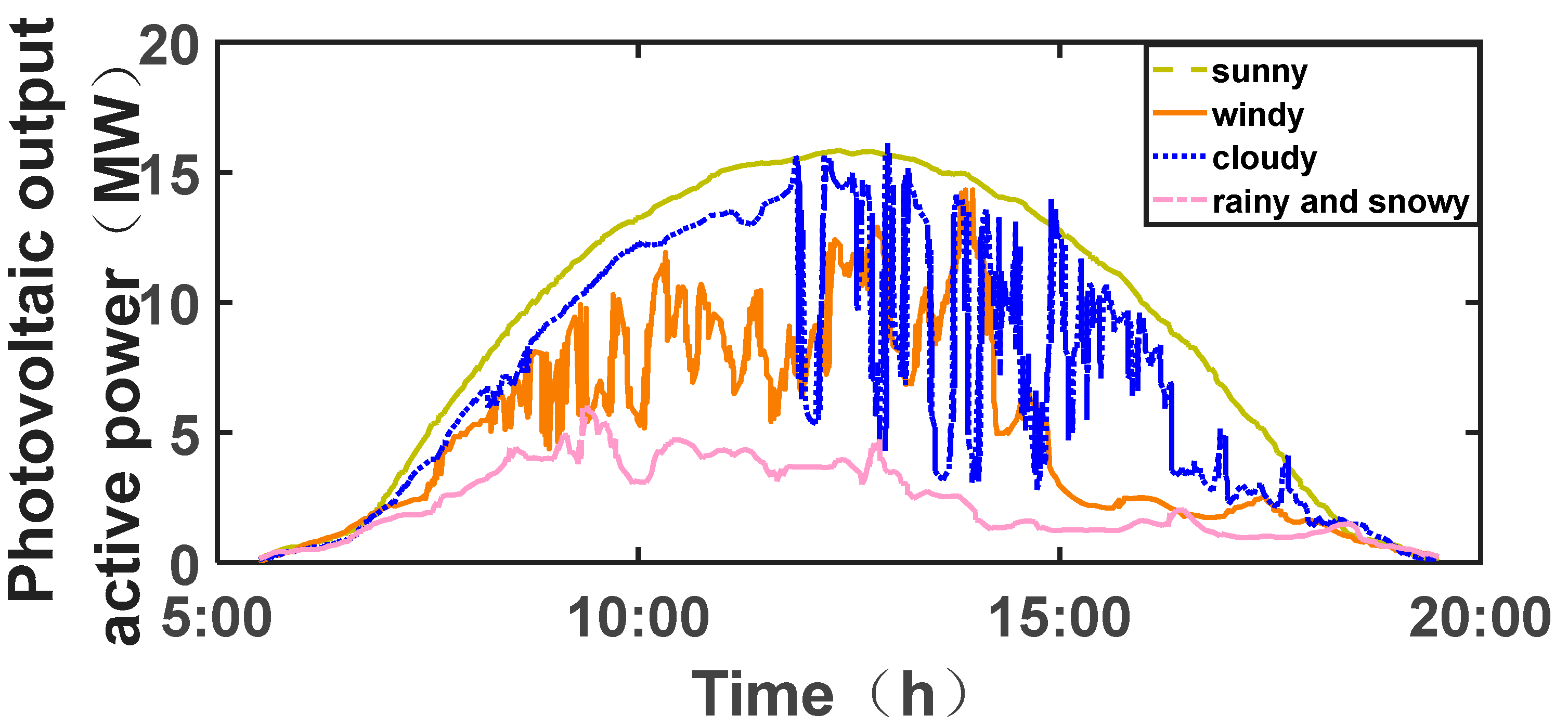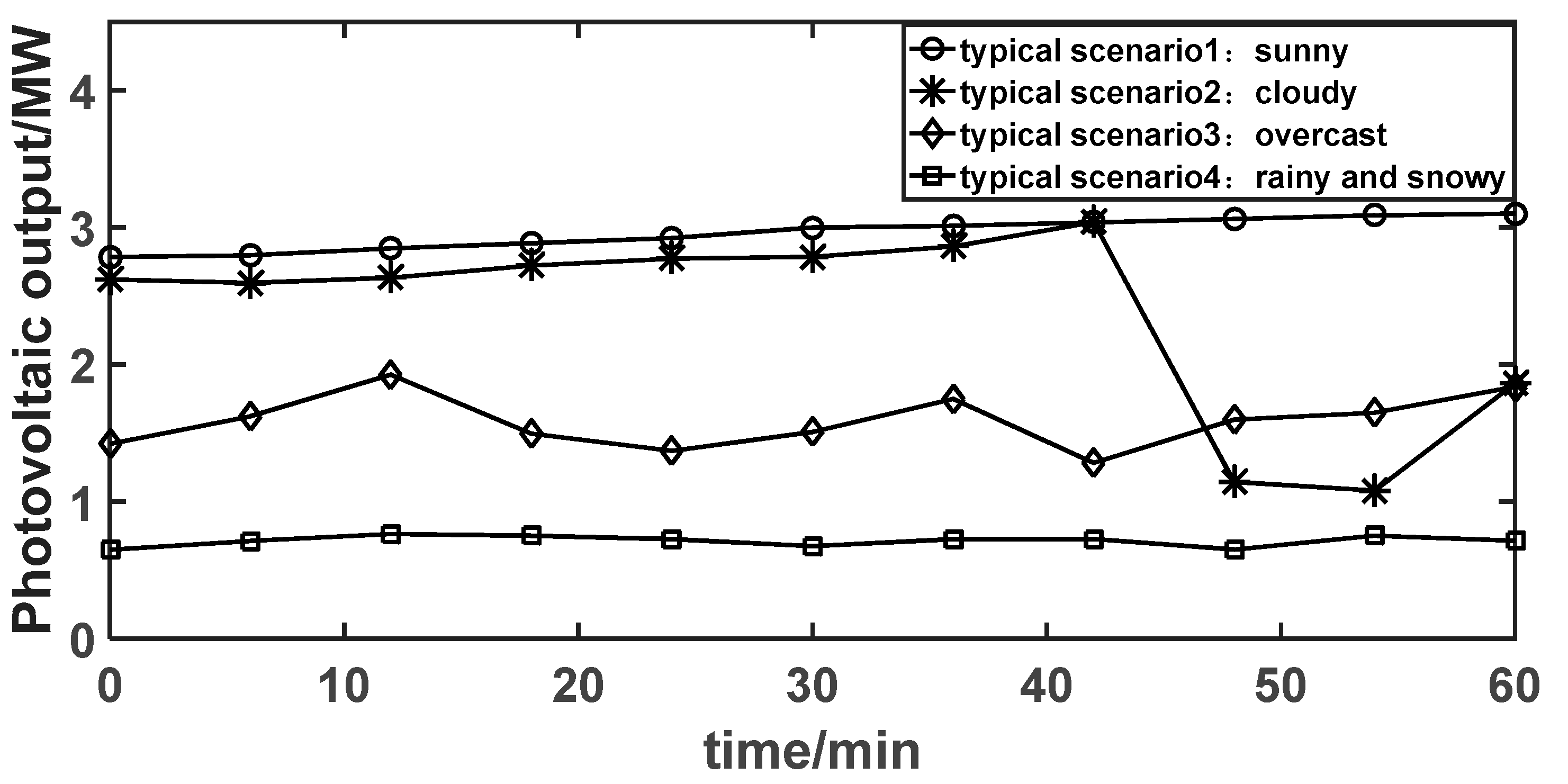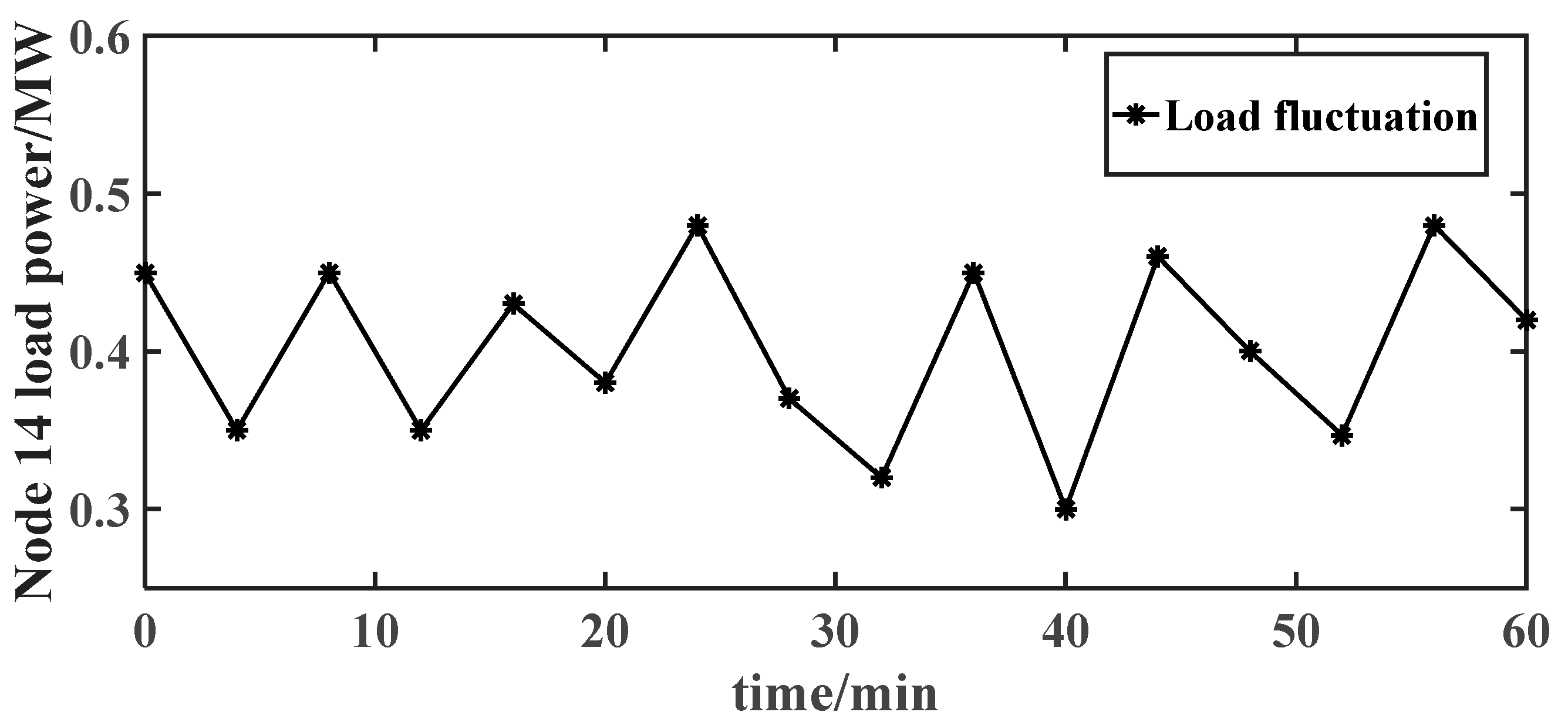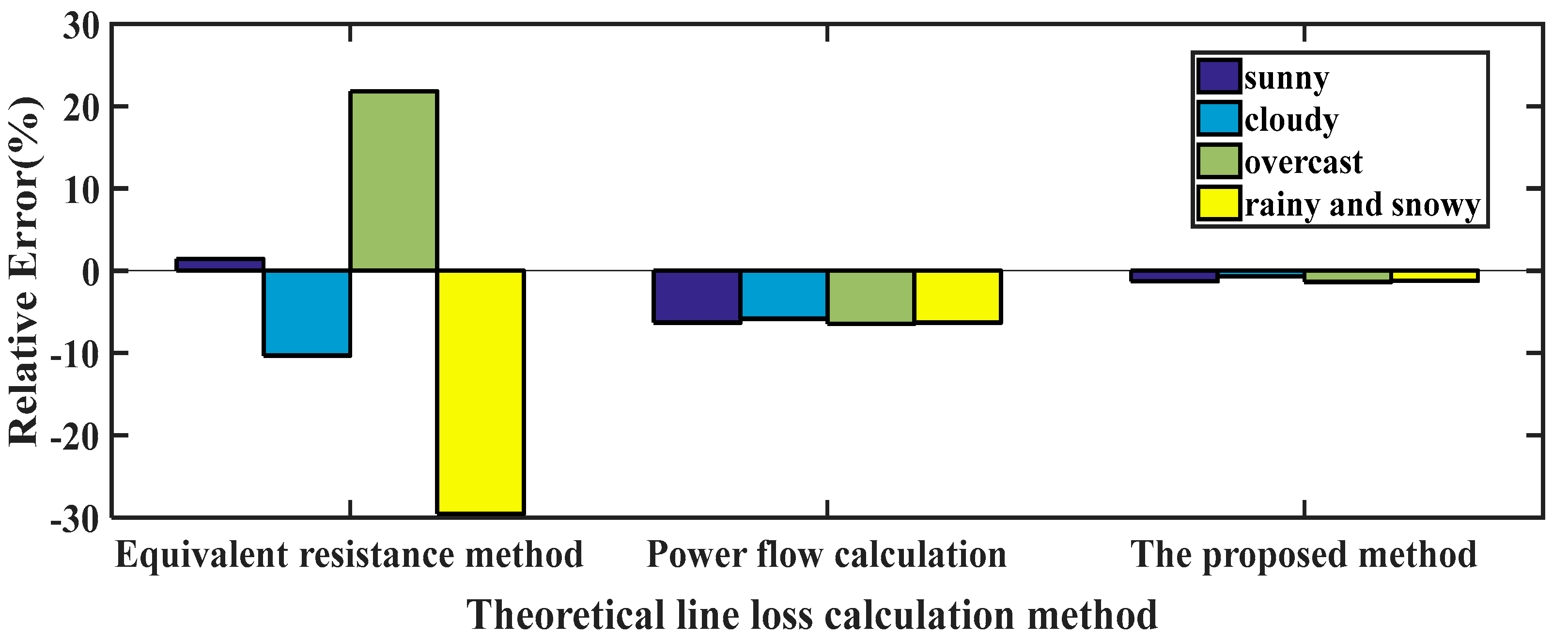Continuous Line Loss Calculation Method for Distribution Network Considering Collected Data of Different Densities
Abstract
:1. Introduction
2. Distribution Network Power Flow Calculation Considering Partial High-Density Collection Data
2.1. Medium Voltage Distribution Network Equipped with Automated Collection Equipment
- (1)
- 10 kV distribution network at the transformer connected to the higher-level grid
- (2)
- Low-voltage side of the transformer in the station area
- (3)
- The connection of low-voltage users to the grid
- (4)
- The connection of DG to the grid
- (a)
- DG information collection device uploads full telemetry and telematics data every 5 min (time interval can be matched).
- (b)
- DG information collection device uploads electricity data once every 15 min (time interval can be assigned).
2.2. Medium Voltage Distribution Network Data Characteristics
- (1)
- The data types are diverse. The collected data mainly include electricity consumption, A, B, and C three-phase voltages, and A, B, and C three-line currents as well as active and reactive power, terminal, and equipment information.
- (2)
- Large data volume. The sampling interval for monitoring terminal voltage, current, and power data is 5–30 min (adjustable in units of 5 min). At present, the sampling interval of the domestic distribution monitoring terminal device is generally 15 min, that is, a node collects 96 points a day. If 10,000 data collection meters have a collection frequency of 15 min/point, one collection can generate 32.61 GB of data, and the data volume will reach 90 TB in a month, which is a very large scale of data [19]. The collection frequency for key users will be higher, such as 5 min/point.
- (3)
- Inconsistent data collection density. The available data can be divided into high-density data and low-density data. 24-point collection means that data are collected once every hour, and the calculated value of this time period is considered to be the average value of this hour; 96-point collection means that data are collected every 15 min, using the average value of those 15 min for calculation. In this paper, the data collected at 96 points and below were considered as low-density data, and those collected at one point per minute were considered as high-density data.
3. Theoretical Line Loss Calculation of Distribution Network with DG
3.1. Model of Each Element of Distribution Network with DG
3.1.1. DG Nodes
3.1.2. The First Branch of the Network
3.1.3. The Load Node
3.2. Continuous Calculation Method for Line Loss Calculation Method for Distribution Network Considering Collected Data of Different Densities
- Entering known quantities, including branch impedance data, node voltage, and power data, etc. where node data include distribution network head node voltage, distributed power node power and voltage, and load node power within a certain time period.
- Calculating the instantaneous power at the load node.
- (1)
- Calculate the power to be distributed, i.e., the sum of the power at the first branch of the network and the power generated by the DG minus the value of the predicted line loss, as calculated in the following equation.In the equation, is the power to be distributed, is the active power to be distributed, is the reactive power to be distributed, is the sum of the power at the first end of the distribution network and the power generated by distributed power sources, and is the predicted line loss rate. The predicted line loss rate is taken as the average of the actual line loss rate of the weekday grid. is calculated by the following equation.
- (2)
- Calculate the instantaneous power at the load node.Assuming that the unknown load is distributed proportionally, i.e., the total generator power is distributed proportionally to the load power and counted as the power of the load, the power of each load node at moment t is calculated by the following equation.In the equation, is the instantaneous active power absorbed by the i-th load node at moment t, is the power distribution coefficient of the i-th load, and is the active power to be distributed in the distribution network at moment t. The calculation of is given in the following equation.The reactive power of each load node at moment t is calculated by the following equation.In the equation, and are the active and reactive electric quantity of the i-th load node at time (t, t + T), respectively, and is the instantaneous reactive power absorbed by the i-th load node at time t.
- Forming a nodal conductance matrix based on the known parameters of each node and each branch, the expression of said nodal conductance matrix is:
- Classifying the system node types into three categories: PQ, PV node, and balance node. PQ nodes denote nodes with known active power P and reactive power Q; PV nodes denote nodes with known active power P and node voltage amplitude; and balance nodes denote nodes with known node voltage amplitudes and phase angles. Consider the distribution network head node as the balance node, DG nodes as PQ nodes, and load nodes as PQ nodes. Set the initial values. Write the power equations for PQ nodes and PV nodes.
- The modified equation is as follows.
- The Jacobian matrix is as follows.
- Solving the correction equation to obtain the node voltage correction.
- Correcting the voltage at each node.
- Determining whether the convergence condition is satisfied; if so, end the loop; if not, return to step 4.
- Calculating power flow is every minute to obtain real-time line power loss.
- Summing over time to find the total loss of a representative time period or representative day.
4. Case Study
5. Conclusions
Author Contributions
Funding
Institutional Review Board Statement
Informed Consent Statement
Data Availability Statement
Conflicts of Interest
References
- Yang, L.X.; Liu, H.; Zhang, H.Y.; Lou, B. Improved shape coefficient method for low voltage grid line loss calculation. Power Demand Side Manag. 2009, 11, 29–32. [Google Scholar]
- Zhang, K.K.; Yang, X.Y.; Bu, C.R.; Ru, W.; Liu, C.J.; Yang, Y.; Chen, Y. Theoretical line loss analysis and loss reduction measures of distribution network based on load measurement. Chin. J. Electr. Eng. 2013, 33, 92–97. [Google Scholar]
- Zhuoqiong, L.; Junchao, Z. Analysis of the factors influencing the loss of medium voltage lines in distribution networks based on mutual information and countermeasure theory. Smart Power 2017, 45, 75–79. [Google Scholar]
- Wang, E.; Cao, M.; Zhang, R.X.; Yang, L.C.; Tang, B.; Lian, X.; Li, B. Research on optimal line loss apportionment method based on spectral mass center migration. Smart Power 2019, 47, 114–120. [Google Scholar]
- Jun, S. A Power Power Flow Calculation for Theoretical Line Loss Calculation. Master’s Thesis, Dalian University of Technology, Dalian, China, 2004. [Google Scholar]
- Chen, D.Z.; Guo, Z.Z. Theoretical line loss calculation for distribution networks based on load acquisition and matching power flow calculation. Grid Technol. 2005, 29, 80–84. [Google Scholar]
- Liu, D.; Chen, Y.P.; Shen, G.; Fan, Y.P. Impact of load randomness on line loss calculation and distribution network reconfiguration. Power Syst. Autom. 2006, 9, 25–28+55. [Google Scholar]
- Fu, Z.W.; Liu, H.J. Line loss calculation of power system considering the influence of load curve and generation output curve. Guangxi Electr. Power 2004, 4, 1–3. [Google Scholar]
- Zhu, Z.Z.; Ye, F.J. An improved algorithm for theoretical line loss calculation of low-voltage distribution networks. Electr. Meas. Instrum. 2012, 49, 6–10. [Google Scholar]
- Shu, Q.Q.; Xiao, J.H.; Ren, W.M.; Yang, L.; Chen, L.K. Research on distribution network line loss analysis methods in power systems. Autom. Instrum. 2018, 3, 28–31. [Google Scholar]
- Zhang, Q.X.; Chang, G. Analysis of distribution network line loss calculation methods and their applicability. China Rural. Water Conserv. Hydropower 2015, 5, 180–184. [Google Scholar]
- Scott, N.C.; Atkinson, D.J.; Morrell, J.E. Uses of load control to regulate voltage on distribution network swish embedded generation. IEEE Trans. Power Syst. 2002, 17, 510–515. [Google Scholar] [CrossRef]
- Kojovic, L. Impact of DG on voltage regulation. In Proceedings of the Power Engineering Society Summer Meeting, Chicago, IL, USA, 21–25 July 2002; pp. 160–165. [Google Scholar]
- Dolezal, J.; Santarius, P.; Tlusty, J. The Effect of dispread generation on power quality in distribution system. In Proceedings of the CIGRE/IEEE PES International Symposium, Montreal, QC, Canada, 8–10 October 2003; pp. 204–207. [Google Scholar]
- Dugan, R.C. Operation conflicts for distributed generation system. In Proceedings of the Rural Electric Power Conference, Little Rock, AR, USA, 29 April–1 May 2001; pp. 401–405. [Google Scholar]
- Zeineldin, H.H.; Sharaf, H.M.; Ibrahim, D.K.; El-Zahab, E.E.-D.A. Optimal Protection Coordination for Meshed Distribution Systems With DG Using Dual Setting Directional Over-Current Relays. IEEE Trans. Smart Grid 2014, 6, 115–123. [Google Scholar] [CrossRef]
- Sookrod, P.; Wirasanti, P. Overcurrent relay coordination tool for radial distribution systems with distributed generation. In Proceedings of the 2018 5th International Conference on Electrical and Electronic Engineering (ICEEE), Istanbul, Turkey, 3–5 May 2018; pp. 13–17. [Google Scholar]
- Xu, D.; Girgis, A. Optimal load shedding strategy in power systems with distributed generation. In Proceedings of the IEEE Power Engineering Society Transmission and Distribution Conference, Columbus, OH, USA, 28 January–1 February 2001; pp. 788–793. [Google Scholar]
- Hegazy, Y.G. Intention islanding of distributed generation for reliability enhancement. In Proceedings of the CICGE/IEEE PES International Symposium, Montreal, QC, Canada, 8–10 October 2003; pp. 208–213. [Google Scholar]
- Liu, Y.; Wang, C.Y.; Xia, D.M. Analysis of the impact of grid faults on grid frequency due to large area wind power LVRT and measures. Power Grid Technol. 2021, 45, 3505–3514. [Google Scholar]
- Chiradeja, P.; Ngaopitakkul, A. The impacts of electrical power losses due to distributed generation integration to distribution system. In Proceedings of the International Conference on Electrical Machines and Systems (ICEMS), Busan, Korea, 26–29 October 2013; pp. 1330–1333. [Google Scholar] [CrossRef]
- Ymeri, A.; Dervishi, L.; Qorolli, A. Impacts of Distributed Generation in Energy Losses and voltage drop in 10 kV line in the Distribution System. In Proceedings of the 2014 IEEE International Energy Conference (ENERGYCON), Dubrovnik, Croatia, 13–16 May 2014; pp. 1315–1319. [Google Scholar] [CrossRef]
- Chiradeja, P.; Ngaopitakkul, A. The impact of capacity and location of multidistributed generator integrated in the distribution system on electrical line losses, reliability, and interruption cost. Environ. Prog. Sustain. Energy 2015, 34, 1763–1773. [Google Scholar] [CrossRef]
- Khosravi, M.; Monsef, H.; Aliabadi, H.M. Loss allocation in distribution network including distributed energy resources (DERs). Int. Trans. Electr. Energ. Syst. 2018, 28, e2548. [Google Scholar] [CrossRef]
- Han, S.; Gao, X.N.; Qiu, G.Y.; Gao, H.; Zhao, W.H.; Song, H. Estimation method of distribution network line loss considering distributed power sources. J. Power Sci. Technol. 2009, 24, 76–82. [Google Scholar]
- Shi, L.Z.; Luo, Y.F.; Liu, W.; Chen, G.B. A solution to the problem of calculating small and medium power sources for distribution network line loss theory--equivalent capacity method. Cent. China Electr. Power 1997, 5, 11–13. [Google Scholar]
- Wang, H.K.; Wang, S.X.; Pan, Z.X.; Wang, J.M. Optimized scheduling method for flexibility enhancement of distribution networks containing high penetration distributed power sources. Power Syst. Autom. 2018, 42, 86–93. [Google Scholar]
- Luo, T.Y. Calculation and Optimization of Cross-Regional Large Grid Losses. Master’s Thesis, Shenzhen University, Shenzhen, China, 2019. [Google Scholar]
- Fu, X.Q. Optimal Allocation of DG Considering Line Loss and Power Quality of Distribution Network. Master’s Thesis, South China University of Technology, Guangzhou, China, 2015. [Google Scholar]
- He, X.H. A Theoretical Line Loss Calculation Method for Distribution Networks with Distributed Power Sources. Master’s Thesis, Hunan University, Changsha, China, 2009. [Google Scholar]
- Zu, Y. Power Quality Analysis Method Based on Electricity Consumption Information Collection Data. Master’s Thesis, Xi’an University of Technology, Xi’an, China, 2020. [Google Scholar]







| Typical Scenario | Corresponding Weather | Line Loss Rate of Traditional Equivalent Resistance Method | Line Loss Rate of Power Flow Calculation | Line Loss Rate of the Method in This Paper | Actual Line Loss Rate |
|---|---|---|---|---|---|
| Scenario 1 | sunny | 4.78% | 4.42% | 4.66% | 4.72% |
| Scenario 2 | cloudy | 5.17% | 5.43% | 5.73% | 5.77% |
| Scenario 3 | windy | 6.24% | 4.79% | 5.05% | 5.12% |
| Scenario 4 | rainy and snowy | 4.51% | 6.00% | 6.33% | 6.40% |
| Typical Scenario | Relative Error of Traditional Equivalent Resistance Method | Relative Error of Power Flow Calculation | Relative Error of Method in This Paper |
|---|---|---|---|
| Scenario 1 | 1.42% | −6.30% | −1.29% |
| Scenario 2 | −10.32% | −5.84% | −0.69% |
| Scenario 3 | 21.82% | −6.45% | −1.36% |
| Scenario 4 | −29.56% | −6.32% | −1.21% |
| Typical Scenario | Relative Error of Traditional Equivalent Resistance Method | Relative Error of Power Flow Calculation | Relative Error of Method in This Paper |
|---|---|---|---|
| Scenario 1 | 14.10% | −3.85% | −0.64% |
| Scenario 2 | −4.82% | −3.55% | −0.38% |
| Scenario 3 | −8.84% | −5.80% | −1.45% |
| Scenario 4 | −9.82% | −1.83% | −0.68% |
| Typical Scenario | Relative Error of Traditional Equivalent Resistance Method | Relative Error of Power Flow Calculation | Relative Error of Method in This Paper |
|---|---|---|---|
| Scenario 1 | 28.09% | −4.26% | −0.43% |
| Scenario 2 | −7.60% | −4.48% | −0.78% |
| Scenario 3 | 33.65% | −5.21% | −1.18% |
| Scenario 4 | −10.30% | −3.72% | −1.01% |
| Typical Scenario | Relative Error of Traditional Equivalent Resistance Method | Relative Error of Power Flow Calculation | Relative Error of Method in This Paper |
|---|---|---|---|
| Scenario 1 | 16.80% | −3.85% | −1.18% |
| Scenario 2 | −13.20% | −2.71% | −0.59% |
| Scenario 3 | 10.56% | −3.38% | −0.97% |
| Scenario 4 | −11.76% | −2.02% | −0.11% |
Publisher’s Note: MDPI stays neutral with regard to jurisdictional claims in published maps and institutional affiliations. |
© 2022 by the authors. Licensee MDPI, Basel, Switzerland. This article is an open access article distributed under the terms and conditions of the Creative Commons Attribution (CC BY) license (https://creativecommons.org/licenses/by/4.0/).
Share and Cite
Li, Y.; Ma, X.; Liang, C.; Li, Y.; Cai, Z.; Jiang, T. Continuous Line Loss Calculation Method for Distribution Network Considering Collected Data of Different Densities. Energies 2022, 15, 5171. https://doi.org/10.3390/en15145171
Li Y, Ma X, Liang C, Li Y, Cai Z, Jiang T. Continuous Line Loss Calculation Method for Distribution Network Considering Collected Data of Different Densities. Energies. 2022; 15(14):5171. https://doi.org/10.3390/en15145171
Chicago/Turabian StyleLi, Yuying, Xiping Ma, Chen Liang, Yaxin Li, Zhou Cai, and Tong Jiang. 2022. "Continuous Line Loss Calculation Method for Distribution Network Considering Collected Data of Different Densities" Energies 15, no. 14: 5171. https://doi.org/10.3390/en15145171
APA StyleLi, Y., Ma, X., Liang, C., Li, Y., Cai, Z., & Jiang, T. (2022). Continuous Line Loss Calculation Method for Distribution Network Considering Collected Data of Different Densities. Energies, 15(14), 5171. https://doi.org/10.3390/en15145171






